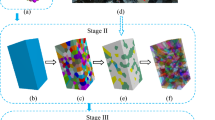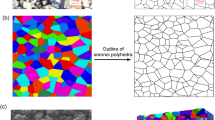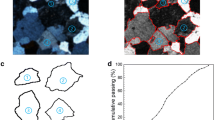Abstract
It is known that rigid circular particle models proposed in the literature do not properly reproduce the rock friction angle and the rock tensile strength to compressive strength ratio. A 2D rigid particle model is here presented which tries to overcome these issues while keeping the simplicity and the reduced computational costs characteristic of circular particle models. A particle generation algorithm is adopted which generates polygonal shape particles based on the Laguerre–Voronoi diagrams of the circular particle gravity centres. Several parametric studies are presented to show the influence of the micromechanical properties on both the macroscopic elastic and strength properties. It is shown that a good agreement with the known rock direct tensile to indirect tensile test ratio requires the incorporation of bilinear softening contact laws under tension and shear. Finally, the proposed model is validated against known triaxial and Brazilian tests of a granite rock.






















Similar content being viewed by others
Abbreviations
- \(\bar{E}_{{}}\) :
-
Young’s modulus of the equivalent continuum material
- \(\eta_{{}}\) :
-
Contact shear stiffness to contact normal stiffness ratio
- \(\sigma_{{n{ \cdot }t}}\) :
-
Maximum contact tensile stress
- \(\tau_{{}}\) :
-
Maximum contact cohesion stress
- \(\mu_{\text{c}}\) :
-
Contact frictional term
- \(G_{{{\text{f}}{ \cdot }{\text{n}}}}\) :
-
Contact tensile fracture energy
- \(G_{{{\text{f}}{ \cdot }{\text{s}}}}\) :
-
Contact shear fracture energy
- \(\bar{W}_{{}}\) :
-
Contact interface width given by the Voronoi cell edge length
- \(E_{{}}\) :
-
Young’s modulus
- \(\upsilon_{{}}\) :
-
Poisson’s coefficient
- \(\sigma_{\text{c}}\) :
-
Uniaxial compressive strength
- \(\sigma_{{{\text{t}}.{\text{dir}}}}\) :
-
Direct tensile strength
- \(\sigma_{{{\text{t}}.{\text{ind}}}}\) :
-
Indirect tensile strength through Brazilian test
- c :
-
Cohesion
- φ :
-
Friction angle
References
Azevedo N, Lemos J (2005) A generalized rigid particle contact model for fracture analysis. Int J Numer Anal Met 29:269–285
Azevedo N, Lemos J (2013) A 3d generalized rigid particle contact model for rock fracture. Integr Comput Aid E 30(2):277–300
Berton S, Bolander J (2006) Crack band model of fracture in irregular lattices. Comput Method Appl M 195(52):7172–7181
Bieniawski Z (1967) Mechanism of brittle fracture of rock. Part I—theory of the fracture process. Int J Rock Mech Min 4:395–406
Bolander J, Saito S (1998) Fracture analyses using spring networks with random geometry. Eng Appl Fr 61(8):569–591
Brace W, Paulding B, Scholz C (1966) Dilatancy in the fracture of crystalline rocks. J Geophys Res 71(16):3939–3953
Cho N, Martin C, Sego DC (2010) A clumped particle model for rock. Int J Rock Mech Min 44:997–1010
Cundall P (1987) Distinct element models for rock and soil structure. In: Brown ET (ed) Analytical and computational methods in engineering rock mechanics, Chapter 4, Allen & Unwin, London, pp 129–163
Cundall P (2001) Discontinuous future for numerical modelling in Geomechanics? P I Civil Eng Geotec 149(1):41–47
Cusatis P, Bazant Z, Cedolin L (2006) Confinement-shear lattice CSL model for fracture propagation in concrete. Comput Method Appl M 195:7154–7171
Diederichs M (2000) Instability of hard rock masses: the role of tensile damage and relaxation. PhD Dissertation, University of Waterloo
Diederichs M (2003) Rock fracture collapse under low confinement conditions. Rock Mech Rock Eng 36:339–381
Erarslan N, Williams D (2012) Experimental, numerical and analytical studies on tensile strength of rocks. Int J Rock Mech Min 49:21–30
Hentz S, Daudeville L, Donze V (2004) Identification and Validation of a discrete element model for concrete. J Eng Mech Asce 6:709–719
Hohberg J (1992) A joint element for the nonlinear dynamic analysis of arch dams. PhD Dissertation. Institute of Structural Engineering, ETH, Zurich, Switzerland
Kazerani T (2011) Micromechanical study of rock fracture and fragmentation under dynamic loads using discrete element method. PhD Dissertation, École Polytechnique Fédérale de Lausanne, Switzerland
Kazerani T, Zhao J (2010) Micromechanical parameters in bonded particle method for modelling of brittle material failure. Int J Numer Anal Met 34(18):1877–1895
Klanphumeesri S (2010) Direct tension tests of rock specimens. Msc Thesis, Suraranee University of Technology, Thailand
Lan H, Martin C, Hu B (2010) Effect of heterogeneity of brittle rock on micromechanical extensile behaviour during compression loading. J Geophys Res 1:14–115
Lilliu J, Van Mier M (2003) 3D lattice type fracture model for concrete. Eng Fract Mech 70(7–8):841–927
Martin C, Chandler N (1994) The progressive fracture of Lac du Bonnet granite. Int J Rock Mech Min 31(6):643–659
Matsuda Y, Iwase Y (2002) Numerical simulation of rock fracture using three-dimensional extended discrete element method. Earth Planets Space 54(367):378
Meguro K, Hakuno M (1989) Fracture analysis of concrete structures by the modified distinct element method. Struct Eng/Earthqu Eng JSCE 6(2):283–294
Nagai K, Sato Y, Ueda T (2005) Mesoscopic simulation of failure of mortar and concrete by 3D RBSM. J Adv Concr Technol 3(3):385–402
Okabe A, Boots B, Sugihara K (1992) Spatial tesselations. Concepts and applications of Voronoi diagrams, Wiley, New York
Potyondy D (2010) A grain based model for rock: approaching the true microstructure. In: Li C et al (eds) Proceedings of Berg Mekanikk i Norden 2010—rock mechanics in the Nordic countries. Konsberg, Norwegian group for rock mechanics, pp 225–234
Potyondy D (2012) A flat-jointed bonded-particle material for hard rock. In: Proceeeding of 46th U.S. rock mechanics/geomechanics symposium, Chicago, USA, pp 24–27
Potyondy D, Cundall P (2004) A bonded-particle model for rock. Int J Rock Mech Min 41:1329–1364
Potyondy D, Cundall P, Lee C (1996) Modelling rock using bonded assemblies of circular particles. In: Aubertin M et al (eds) Proceedings of the 2nd North American rock mechanics symposium. Balkema, Rotterdam, pp 1937–1944
Rokugo K, Iwasa M, Susuki T, Koyanagi W (1989) Testing methods to determine tensile strain softening curve and fracture energy of concrete. In: Mihasi H et al (eds) Fracture toughness and fracture energy: test methods for concrete and rock. Balkema, Rotterdam, pp 153–163
Schlangen E, Garboczi E (1997) Fracture simulations of concrete using lattice models: Computational aspects. Eng Fract Mech 319(2/3):332–357
UDEC (2004) Universal Distinct Element Code, Version 4.0, Itasca consulting group, Minneapolis
Underwood P (1983) Dynamic relaxation. In: Belytschko T, Hughes T (eds) Computation methods for transient analysis. North-Holland, New York, pp 246–265
Vasconcelos G (2005) Investigação experimental na mecânica da alvenaria de pedra: Caracterização de granitos e comportamento de paredes antigas de alvenaria de pedra. PhD Dissertation. Univesidade do Minho, Portugal (in Portuguese)
Wang Y, Tonon F (2009) Modeling Lac du Bonnet granite using a discrete element model. Int J Rock Mech Min 46(1124):1135
Acknowledgments
This work was developed within the research project PTDC/ECM/114492/2009 funded by the Portuguese Foundation of Science and Technology.
Author information
Authors and Affiliations
Corresponding author
Rights and permissions
About this article
Cite this article
Monteiro Azevedo, N., Candeias, M. & Gouveia, F. A Rigid Particle Model for Rock Fracture Following the Voronoi Tessellation of the Grain Structure: Formulation and Validation. Rock Mech Rock Eng 48, 535–557 (2015). https://doi.org/10.1007/s00603-014-0601-1
Received:
Accepted:
Published:
Issue Date:
DOI: https://doi.org/10.1007/s00603-014-0601-1




